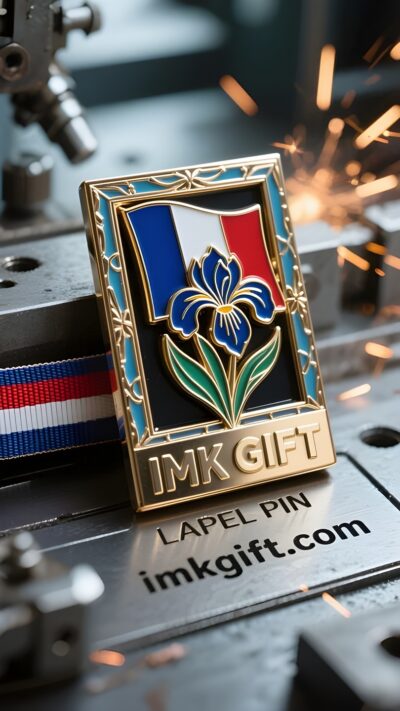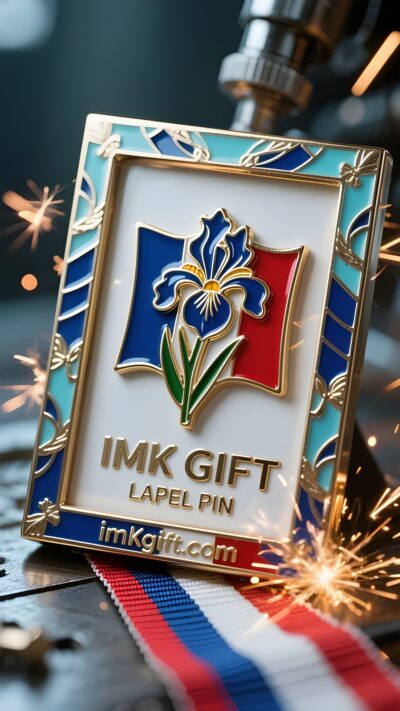in983-La-lumière-de-la-France-dans-le-cadre-de-l-39-iris
▼
Le 14 juillet, le ciel de Paris s’illuminait de bleu, de blanc et de rouge. Lors du défilé militaire sur les Champs-Élysées, les soldats arboraient des iris sur la poitrine, complétant le drapeau national flottant au vent. Ce symbole, baigné du sang de la France, tout comme les cadres dorés incrustés de motifs d’iris du musée, préserve non seulement l’histoire, mais laisse aussi place à l’avenir. La forme arquée du cadre orné d’iris s’inspire de l’architecture gothique du Moyen Âge, et les trois pétales s’inscrivent dans l’esprit moderne de « liberté, égalité et fraternité ». Devant la peinture à l’huile du château de Versailles, le décor doré est tel un mur incassable et une porte toujours ouverte : il encadre les symboles éternels du caractère national, sans jamais obstruer la lumière du monde extérieur. Tout comme le drapeau tricolore né lors de la tempête de juillet, il perpétue non seulement le symbole du pouvoir royal de l’iris, mais fait aussi fondre le sang des révolutionnaires. Lorsque le feu d’artifice de la Fête nationale a éclaté à la Tour Eiffel, les cadres photo qui ont traversé le temps et l’espace nous le disaient encore : la véritable protection ne consiste pas à emprisonner le passé, mais à fournir un système de coordonnées pour chaque nouvelle ère. À l’image du nouveau mur-rideau de verre construit sur les quais de la Seine, il reflète non seulement la rosace de la Sainte-Chapelle, mais aussi les étoiles brillantes. La sagesse française réside dans le savoir-faire des cadres traditionnels pour soutenir la toile innovante, afin que les coups de pinceau de chaque époque trouvent un point d’ancrage dans la latitude et la longitude historiques. En regardant l’Arc de Triomphe en ce moment, les douze avenues qui rayonnent depuis la place de l’Étoile ne sont-elles pas seulement un iris géant en plein cœur de Paris ? Il encadre toutes les possibilités dans toutes les directions, avec une attitude inclusive, à l’image de cette nation en quête constante d’un équilibre entre persévérance et percée. C’est le sens profond du cadre photo : il doit y avoir des limites claires, mais aussi un espace d’expression suffisant.
On July 14, the sky of Paris was lit up by blue, white and red. At the military parade on the Champs-Elysées, soldiers wore iris badges on their chests, which complemented the national flag fluttering in the wind. This mark flowing in the blood of France, just like the gilded frames inlaid with iris patterns in the museum, not only guards the history, but also leaves space for the future. The arc top shape of the iris frame is derived from the Gothic architecture of the Middle Ages, and the three petals are in line with the modern spirit of “freedom, equality and fraternity”. Standing in front of the oil painting of the Palace of Versailles, the gilded decoration is like an unbreakable wall and a door that is always open – it frames the eternal coordinates of national character, but never blocks the light from the outside world. Just as the tricolor flag was born in the July Storm, it not only continues the symbol of royal power of the iris, but also melts the blood of revolutionaries. When the National Day fireworks bloomed at the Eiffel Tower, the photo frames that traveled through time and space were still telling us: the real protection is not to imprison the past, but to provide a coordinate system for each new era. Just like the newly built glass curtain wall building on the banks of the Seine, it not only reflects the rose window of the Sainte-Chapelle, but also refracts the brilliant stars. The wisdom of France lies in knowing how to use traditional frames to hold up the innovative canvas, so that the brushstrokes of each era can find a landing point in the historical latitude and longitude. Looking down at the Arc de Triomphe at this moment, the twelve avenues radiating from the Place de l’Etoile are not just a giant iris blooming in the heart of Paris? It frames all possibilities in all directions with an inclusive attitude, just as this nation is always looking for a balance between perseverance and breakthrough. This is the deepest meaning of the photo frame: there must be clear boundaries, but also enough space for expression.
七月十四日,巴黎的天空被蓝白红三色点燃。香榭丽舍大街的阅兵式上,士兵们胸前别着鸢尾花徽章,与迎风招展的国旗交相辉映。这抹流淌在法兰西血脉中的印记,正如博物馆里那些镶嵌着鸢尾纹饰的鎏金相框,既守护着历史,又为未来留白。
鸢尾花相框的弧顶造型源自中世纪的哥特建筑,三重花瓣暗合”自由、平等、博爱”的现代精神。在凡尔赛宫的油画前驻足,鎏金纹饰既像牢不可破的城墙,又似永远敞开的门扉——它框定的是民族品格的永恒坐标,却从不阻挡外界的光照入。正如三色旗在七月风暴中诞生,既延续了鸢尾的王权象征,又熔铸了革命者的热血。
当国庆烟花在埃菲尔铁塔绽放,那些穿越时空的相框仍在诉说:真正的守护不在于禁锢过往,而在于为每个新时代提供坐标系。就像塞纳河岸新落成的玻璃幕墙大厦,既倒映着圣礼拜堂的玫瑰窗,又折射出璀璨星河。法兰西的智慧,恰在于懂得用传统的框架托举起创新的画布,让每个时代的笔触都能在历史经纬中找到落点。
此刻俯看凯旋门,星形广场放射出的十二条大道,不正是一朵盛开在巴黎心脏的巨型鸢尾?它用包容的姿态框住所有方向的可能性,正如这个民族始终在坚守与突破中寻找平衡点。这才是相框最深层的寓意:既要有清晰的边界,更要留足挥洒的天地。
▼
Contact Us
📞 Tel: +0086-760-85286839
📧 Email: sales3@imkgift.com








